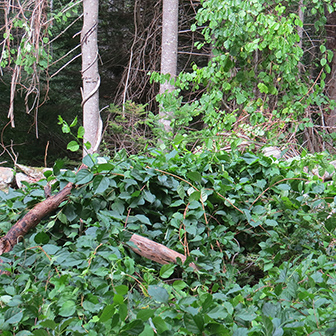Identification and management of invasive plants

Learn how to spot them and ways to deal with them.
In this online workshop, Nancy Olmstead, invasive plant biologist from the Maine Natural Areas Program, covers identification of some of the most common terrestrial invasive plant species in the Midcoast region and provides a brief overview of management options.
An invasive plant is a plant that is not native to an area, whose introduction causes, or has the potential to cause harm – be it economic, environmental or harm to human health. Approximately one third of the species in this area are not native. Of those plants that are not native, only a small fraction of them are considered invasive, but these have the potential to cause great harm to our landscape.
While all non-native plants can efficiently out-compete native species for sunlight, nutrients, and space, invasive plants can cause additional harm by altering animal habitat through elimination of native foods, decreasing available cover, and destroying nesting opportunities. The aggressive growth of invasive plants can decrease agricultural productivity, affect forest regeneration, impact recreational opportunities, and decrease property values. Invasive species are the second-greatest threat to global biodiversity after loss of habitat.
Recorded on June 10, 2020.
For more information
Visit the Maine Natural Area Program’s Gallery of Invasive Plants and their Advisory List of Invasive Plants, with links to fact sheets for each plant.
You can also order the Maine Invasive Plants Field Guide through MNAP’s website.
Taking it further
If you are interested in participating in the iMapInvasives Program, Nancy provided a training on the iMap database for Coastal Rivers staff and volunteers earlier this spring. Watch the recording here.
See more from Coastal Rivers
If you enjoyed this program, you can find more recorded workshops and trainings here.






